If you like salmon, you will LOVE this salmon jerky recipe! It tastes like light fish and ends with a nice smokey and salty taste. Just perfect!.
When it comes to fat content in fish, salmon ranks on the higher end. If you have been reading about jerky, fat is not a good thing. But salmon still makes GREAT jerky!.
I’ll show you how to make salmon jerky that is much better than store-bought kinds.
Drying salmon is an excellent way to preserve this healthy and delicious fish for long term storage. With the right techniques, you can make tasty dried salmon at home that will keep for months in your pantry or freezer.
In this detailed guide I’ll walk you through the entire process of drying salmon, from start to finish. We’ll cover how to select the best salmon for drying prep the fish properly, apply seasonings, choose a drying method, and store your finished product. Follow these tips and you’ll be enjoying delicious homemade dried salmon in no time!
Why Dry Salmon?
There are several benefits to drying salmon rather than eating it fresh
-
Long shelf life – Properly dried salmon can last for 6 months in the pantry and up to a year in the freezer This makes it a handy protein to have on hand.
-
Concentrated flavor – Removing the moisture concentrates the flavors and produces intensely savory dried salmon.
-
Precooked – Dried salmon can be eaten as a ready-to-eat snack without any further cooking required.
-
Lightweight – Dried salmon weighs much less than fresh salmon, making it easy to transport for hiking trips, camping, and other activities.
-
Flexible: Dried salmon can be eaten by itself, added to recipes, or soaked in water to make it soft again.
Selecting Salmon for Drying
You can use any species of salmon for drying, but here are some of the best choices:
-
This type of salmon has dark red meat that is high in good fats. The richness results in very flavorful dried salmon.
-
Coho – Lower in fat than sockeye but still an excellent option. Its delicate flavor comes through when dried.
-
King – The high oil content and fatty texture of king salmon make it a prime candidate for drying.
No matter what type you use, always select fresh, sushi-grade salmon from a reputable seller. Lower quality salmon may increase the risk of spoilage.
Preparing the Salmon
Proper prep is crucial for delicious dried salmon:
-
Clean – Rinse the salmon fillets under cold water and pat dry with paper towels.
-
Portion – Cut the salmon into manageable 2-3 inch wide strips. Even sizes will dry evenly.
-
Skin – Salmon can be dried with or without skin. Leaving it on helps the fish hold together.
-
Slice – Using a sharp knife, slice the salmon lengthwise into 1/4 inch thick slices. Consistent thin slices dry quickly.
-
Remove Pin Bones – Use tweezers or pliers to remove any small pin bones, which can be sharp when dried.
Seasoning Your Salmon
Adding seasonings before drying infuses the salmon with lots of flavor. Try any of these combinations:
-
Lemon pepper and garlic powder
-
Cajun seasoning
-
Brown sugar and soy sauce
-
Italian herbs and chili flakes
-
Salt and onion powder
Brush the seasonings evenly over both sides of the salmon slices before dehydrating. Let them sit for 15-20 minutes so the flavors are absorbed.
Drying Methods for Salmon
You have two main options for drying salmon at home:
Using a Food Dehydrator
This is the easiest and most effective method. Food dehydrators allow precise temperature and time control.
-
Arrange the seasoned salmon slices in a single layer on the dehydrator trays, making sure none overlap.
-
Set the temperature to 145°F and let the salmon dry for 3-5 hours. Rotate the trays and check frequently.
-
The salmon is done when slices are slightly tacky but no longer moist. They will darken and stiffen when dried.
Air Drying
If you don’t have a dehydrator, air drying also works. It just takes more time and attention.
-
Place salmon slices on racks or wire screens so air can circulate on both sides.
-
Position in a dry area with good airflow, away from direct sun. Near a sunny window is ideal.
-
Flip and rotate the slices periodically so they dry evenly. This can take 12-24 hours.
-
Bring the racks indoors at night to prevent re-absorption of moisture from dew.
No matter which method you use, make sure to thoroughly dry the salmon until no moisture remains. Any remaining moisture can allow bacterial growth during storage.
Storing Your Dried Salmon
Properly stored, dried salmon can last for several months in the pantry or up to a year in the freezer. Here are some storage tips:
-
Let the salmon cool completely before packing for storage.
-
Store in an airtight container or heavy zip-top bag. Exclude as much air as possible.
-
Keep in a cool, dark place like the pantry or refrigerator.
-
For longer term storage, place packed salmon in the freezer.
-
Check periodically for moisture and any mold growth. Discard if you see any.
-
For best quality and safety, use within 6 months from when you dried it.
-
Consider vacuum sealing portions for easy grab-and-go snacks.
Enjoying Your Dried Salmon
The intense flavor and chewy texture of dried salmon make it a tasty and nutritious snack or addition to meals. Here are some serving ideas:
-
Eat the dried salmon strips straight as a snack at home or on the go.
-
Chop up the salmon and add to salads, pasta, pizza, rice bowls and more.
-
Soak strips in water for 10-20 minutes to rehydrate, then use in any recipe calling for cooked salmon.
-
Crumble over crackers, toast, potato skins or tacos for an easy topping.
-
Use in place of fresh salmon in your favorite fish recipes.
-
Take it camping or hiking for a lightweight, protein-packed meal component.
From selecting the right salmon to safely storing your finished product, you now have all the information you need to successfully dry salmon at home. Done properly, homemade dried salmon is delicious, nutritious, and will keep for months. Give it a try and enjoy this versatile preserved fish all year round!

How to make salmon jerky
I started with a wild caught sockeye salmon fillet that I purchased from my local grocery store. When I make smoked salmon or dehydrated salmon jerky, I always buy salmon that was caught in the wild.
The taste is sooo much better when it is wild caught. You can tell wild caught from farm raised because of the dark red color of the meat.
Run your fingers over the meat to feel for any pin bones. This picture shows salmon fillets that had a lot of pin bones. Other fillets have had none at all.
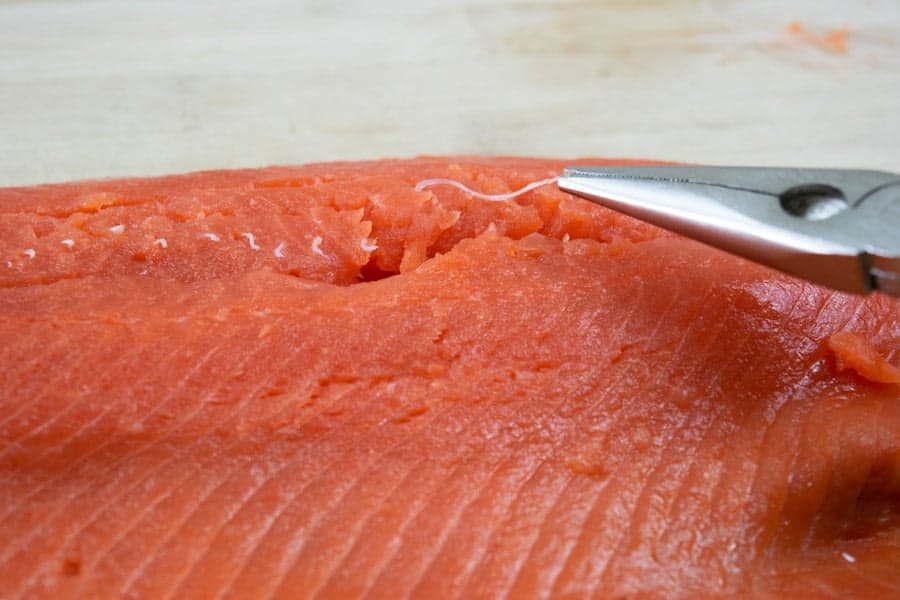
They will feel hard and be white in color. I use standard needle nose pliers to pull them out. They should pull out easily with a little wiggling. Dont forget this step, no one likes bones in their jerky!.
Here is where you can either skin the fillet or leave the skin on. I like leaving the skin on because it keeps the meat together. If you remove the skin now, the strips can break apart easily during marinating.
Once you are done drying, the skin will peel off easily before you eat the jerky.
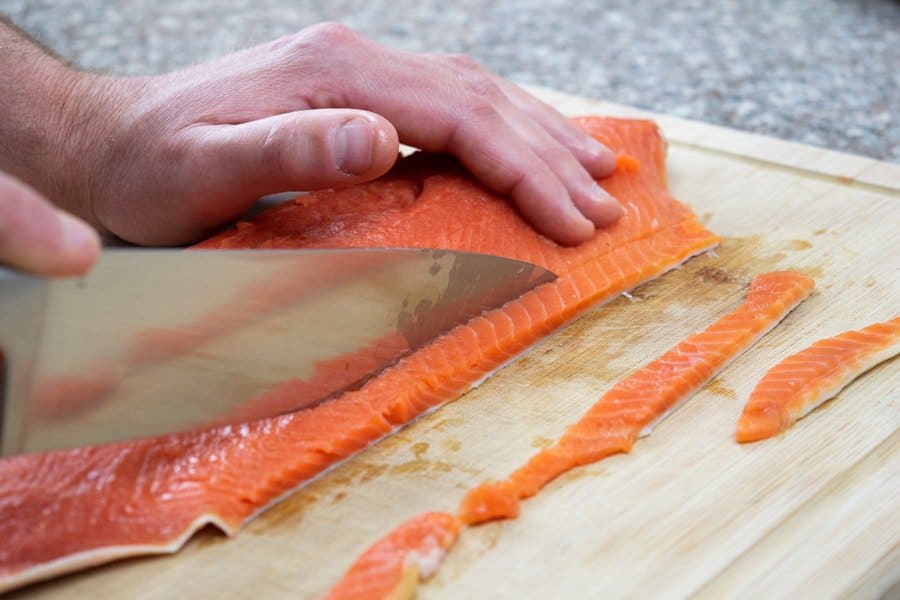
Using a very sharp knife, slice ¼” – ½” wide salmon strips down the length of the fillet. Slicing from the “head” of the fillet to the “tail”.
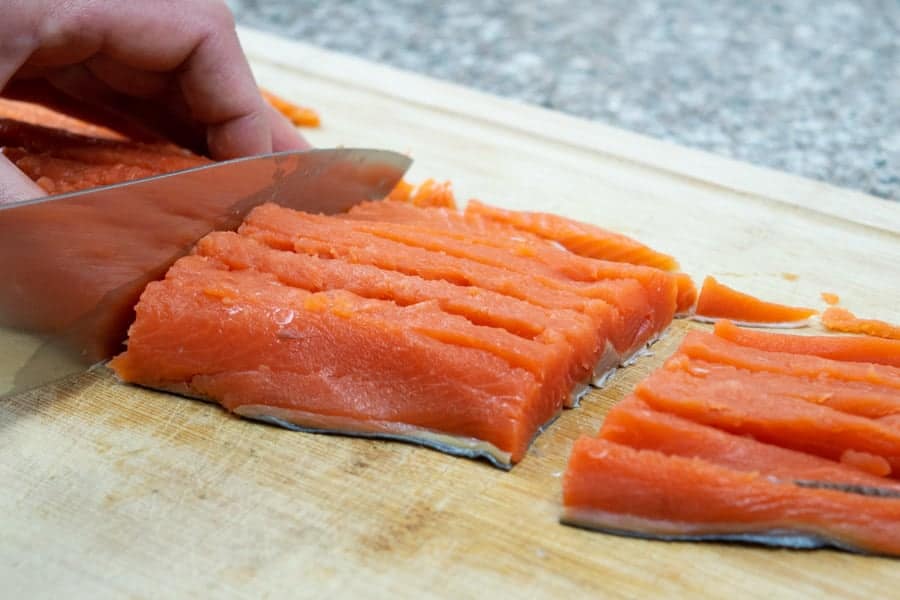
After all the strips are sliced lengthwise, cut across the strips to your desired length. I normally cut mine between 3-4″ long for this salmon jerky recipe.
Mix all the marinade ingredients together in a ziplock bag and add the salmon strips carefully.
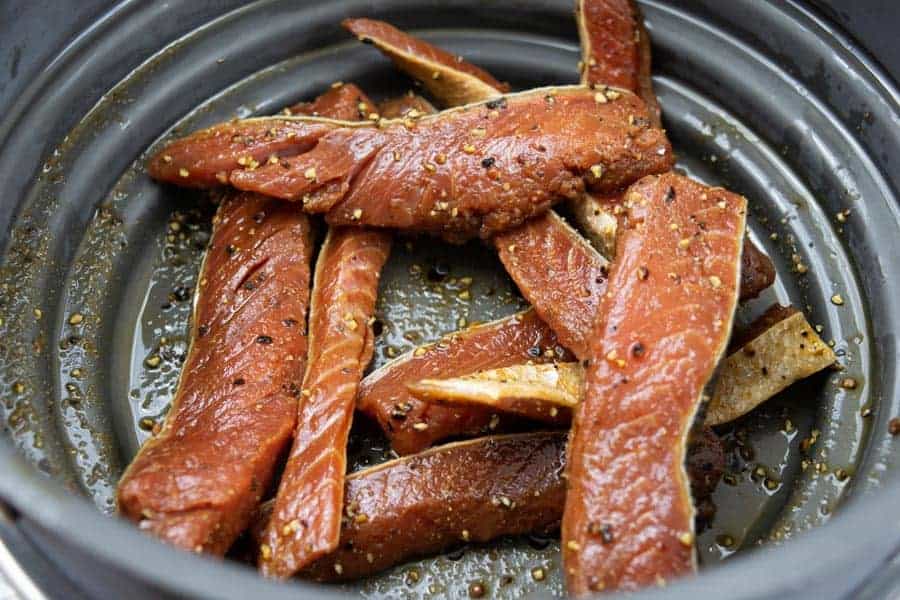
For 18 hours, I put the salmon strips in a ziplock bag and put them in the fridge with the salmon jerky recipe below. Mix up the strips in the bag several times during marinating to ensure all strips are evenly marinated.
Strain the salmon strips in a colander and pat dry with paper towels to remove any excess marinade.
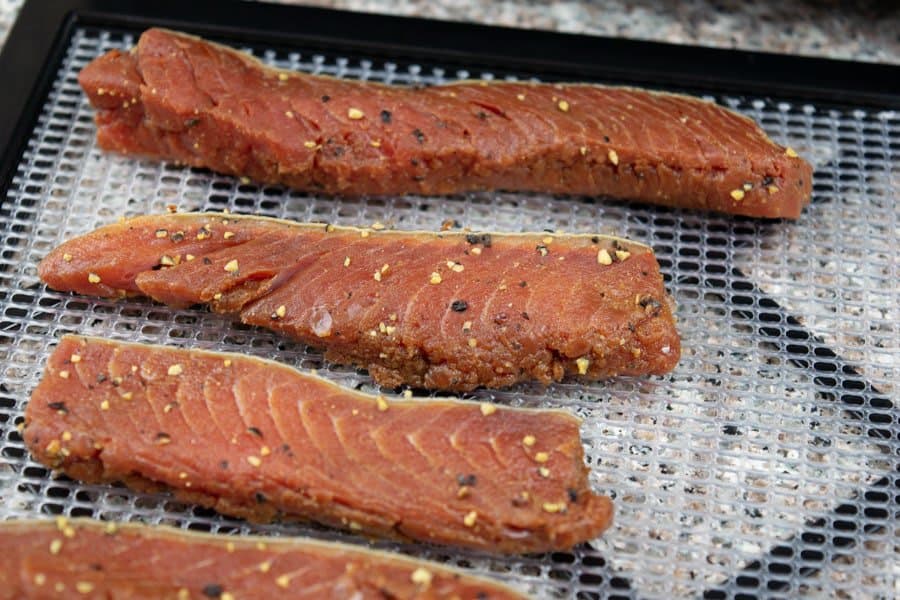
Lay the strips on dehydrator trays or a cooling rack if drying with your oven. Make sure none of the pieces are touching and there is amble room in between for air to circulate. I used my Excalibur Dehydrator when making this recipe.
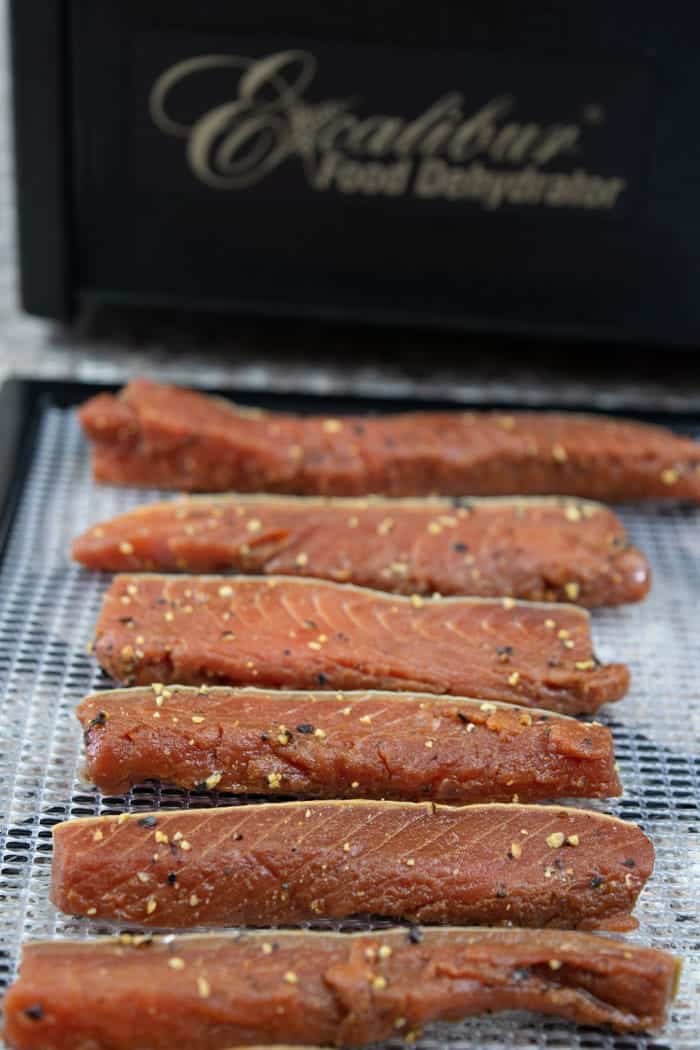
Let the strips dry at 150°F or as low as your oven will go until they are done. Because salmon is high in fat, I like to dry it out more than fish that is low in fat, like my trout jerky recipe. It took this jerky 9 hours to be just perfect.
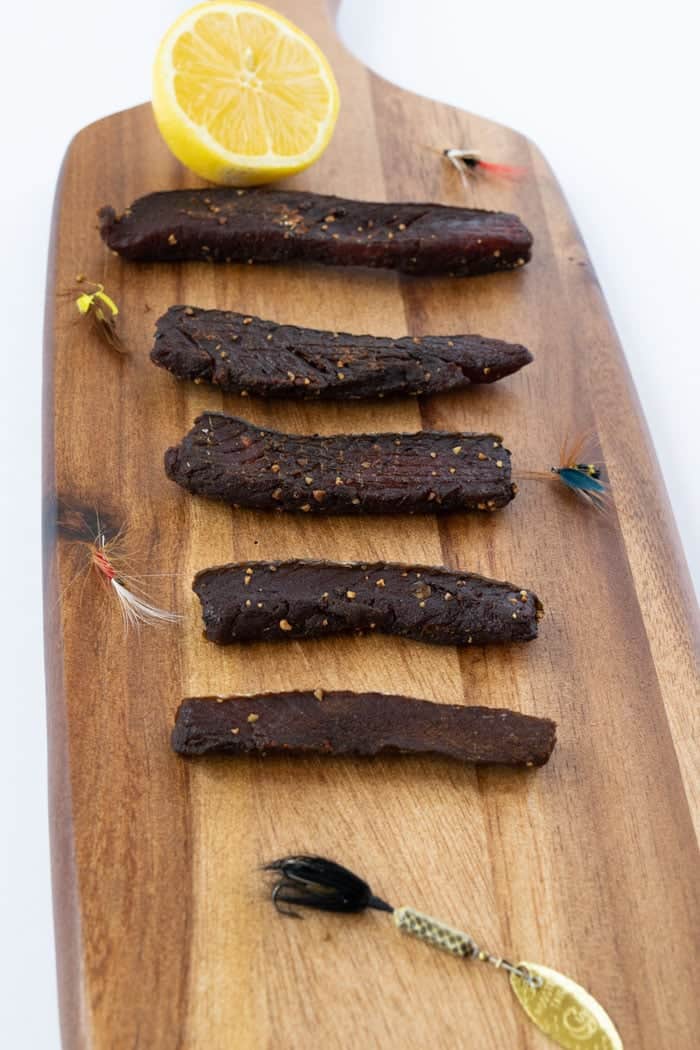
It worked out GREAT! The smokey taste from the liquid smoke and the salty taste from the soy sauce make this salmon jerky taste great.
If you love salmon, you HAVE to make this jerky. Now all you have to do is peel the skin off and eat!.
Try making these other JERKY RECIPES:

Homemade Salmon Jerky – Perfect Snack To Accompany Some Beers
FAQ
How long does it take to dry salmon?
Why should you dry salmon?
How to cut salmon for dehydrating?
How do you dry salmon before smoking?
How do you dry salmon?
When it comes to drying salmon, there are a few different methods that you can choose from. One popular method is to use a food dehydrator. This is a great option if you have one available, as it provides a controlled environment for drying the fish. If you don’t have a food dehydrator, you can also air dry the salmon.
What are the benefits of smoked salmon over raw salmon?
It actually has the same characteristics as raw salmon, being relatively low in calories, it is an excellent source of protein, good fat and several vitamins and minerals. The smoking process just adds an aroma.
Can salmon be dried?
While any type of salmon can be dried, it is best to use species with higher fat content, such as sockeye or coho salmon. These types of salmon will result in a more flavorful and enjoyable dried product. Do I need to add any seasonings before drying? Seasonings can be added before drying to enhance the flavor.
How do you eat dried salmon?
Dried Salmon Salad: Toss dried salmon flakes with mixed greens, cherry tomatoes, cucumbers, and a light vinaigrette for a refreshing and nutritious salad. Dried Salmon Wraps: Spread cream cheese on a tortilla, add dried salmon, sliced avocado, and fresh herbs. Roll it up for a quick and satisfying lunch option.
